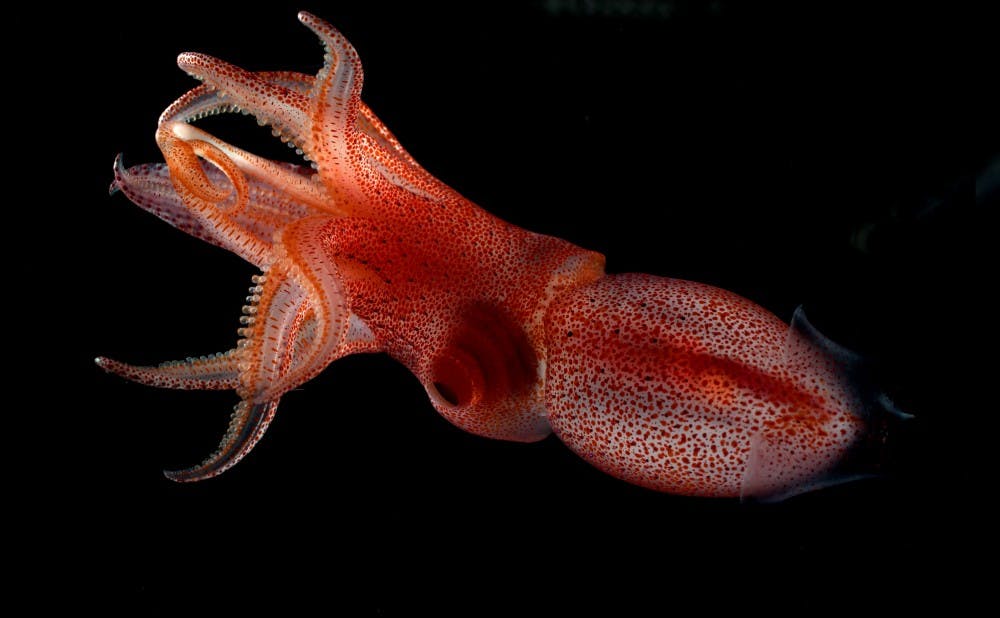Duke researchers have unravelled why the “strawberry squid" has such a strange googly-eyed appearance—its two different sized eyes allow the creature to adapt to its deep-sea habitat.
With one large, bulging, yellow-colored eye and another more normal-sized eye, the squid—referred to by biologists as Histioteuthis heteropsis—has a bizarre appearance that has long puzzled marine biologists. An investigation by Duke scientists finally gained insight into the evolution for such a mismatched visage, suggesting that the squid's large eye has adapted to look upward toward the ocean surface to focus in the shreds of sunlight on other deep sea creatures. The other smaller eye is oriented downward, which the team hypothesizes is used by the squid to search for bioluminescence in the deeper, darker sea.
“The findings are consistent with a hypothesis that Richard Young, [a renowned expert on squids], presented in the 1970s," said graduate student and study co-author Katie Thomas.
Young never had enough specimens to test his theories, but Thomas was able to gather enough resources to support Young's conclusions.
The strawberry squid inhabits the ocean's “twilight zone,” Thomas noted, with a habitat ranging from 660 to 3300 feet under the surface. This has made studying the squid challenging.
“The deep-sea squid are pretty abundant in their natural habitat," Thomas said. "They are often found in the stomachs of whales, but because their habitat is so expansive and large, we were kind of restricted because it takes a long time searching the dark abyss to come across one of these animals. The squids often jet away before data is collected."
In order to conduct her research, Thomas said she carefully combed through an assortment of more than 30 years of deep-sea footage collected and annotated by the Monterey Bay Aquarium Research Institute. She then analyzed the video footage with computer simulations of visual sensitivity, which gave her clues for defining the function of each of the squid’s lopsided eyes.
“I was really fortunate to have been able to analyze over 150 videos worth of footage of these freaky-looking animals," she said. "If I had begun my research without this resource, I doubt I would’ve had these observations to work with."
Besides examining their eyes, Thomas said she was also able to glean insights into the seemingly lazy nature of the strawberry squid's movements.
The team's observations showed that the squids find their way through the sea in an unusual manner, facing their heads downward and their tails up, in a straight vertical formation. This quirky way of moving, the team's research suggests, allows each eye to orient itself in different directions.
Thomas' work on the strawberry squid fits into the larger goals of Duke’s Johnsen Lab, which characterizes the ecological impact of aquatic visual systems.
“We are really interested in the evolution of eyes and the function of those eyes throughout evolutionary history," Thomas said. "All animals that dwell at these sea levels have evolved adaptations to deal with low light levels, but these squids are the only animal that we see that have completely designated each eye for a different task and have evolved to have completely different appearances."
To bolster her team's understanding of the diversity of aquatic visual systems, Thomas is currently working with cephalopod curators at the Smithsonian Museum, studying other species within the strawberry squid's family that have eyes of varying shapes.
“We are studying how eyes change from juvenile squids to adults," she said. "We also want to study the divergence between different species of squids, because the difference in size of the eyes is not usually as drastic as it is among the strawberry squid."
Get The Chronicle straight to your inbox
Signup for our weekly newsletter. Cancel at any time.

